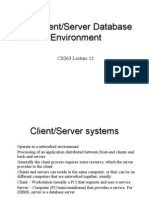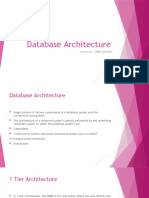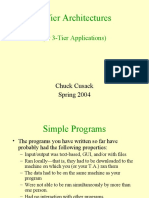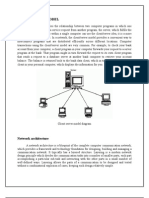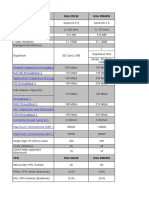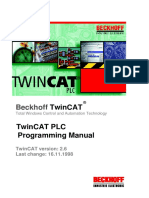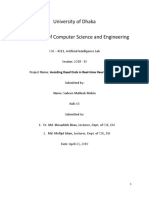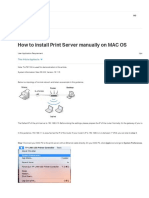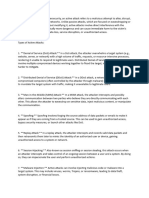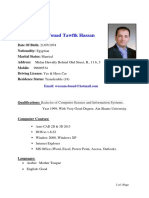CS204: Database Systems
Lab # 01: Introduction to Lab & DB Architecture
Objective:
1-Oracle Software and CD
2-Client Server Concept
3-Introduction to Oracle, its Architecture & Versions
4-Database lab orientation
5-Sample Database Applications
Scope:
The student should know the following:
Oracle Installations issues
Introduction to Oracle and its applications
Oracle Versions etc.
Useful Concepts :
Oracle Software version 11g Enterprise Edition:
Available on Datum network for Vista & Win.7, Win 10. Oracle for MAC OS is not available.
Datum Access:
1) Press Win+R
2) Enter \\172.16.100.104
3) Username : nuisb\i181234
4) Password : Your Wifi’s password
Oracle 11g Enterprise Edition available Setup:
Database 11g R2
(\\172.16.100.104\Software\Development Tools\Database Applications\Oracle)
OR
Oracle11g -11.2.0.1.0-win32.ISO
(\\172.16.100.104\Software\Development Tools\Database Applications\Oracle\Oracle Database 11g
Release 2 )
OR
Oracle11g -11.2.0.1.0-win32-win64.ISO
(\\172.16.100.104\Software\Development Tools\Database Applications\Oracle )
Installation Guide (Installation of Oracle 11g EE DB):
(\\172.16.100.104\Software\Development Tools\Database Applications\Oracle)
https://oracle-base.com/articles/11g/articles-11g
Installation:
1) Create a file to save the Oracle Base (step 8), SID (step 10), and password (step 15).
2) In case of TNS: No listening error.
I. Press Win+R
II. Enter “services.msc”
III. Start/Restart oracle services.
Ejaz Ahmed 1
�Client-Server Architecture
Client–server refers to the way in which software components interact to form a system. There is a client
process, which requires some resource, and a server, which provides the resource. There is no requirement
that the client and server must reside on the same machine. In practice, it is quite common to place a server at
one site in a local area network and the clients at the other sites.
Client Server
Manages the user interface Accepts and processes database requests from
Accepts and checks syntax of user input clients
Processes application logic Checks authorization
Generates database requests and Ensures integrity constraints not violated
transmits to server Performs query/update processing and transmits
Passes response back to user response to client
Maintains system catalog
Provides concurrent database access
Client-Server Architecture (2-Tier)
The client (tier 1) is primarily responsible for the presentation of data to the user, and the server (tier 2) is
primarily responsible for supplying data services to the client. Typically, the client would run on end-user
desktops/mobiles and interact with a centralized database server over a network.
Client-Server Architecture (3-Tier)
In 2-tier Architecture client’s computer required considerable resources to run effectively. This includes disk space,
RAM, and CPU power. So a new architecture was proposed with three layers, each potentially running on a different
platform:
(1) The user interface layer, which runs on the end-user’s computer (the client).
(2) The business logic and data processing layer. This middle tier runs on a server and is often called the application
server.
Ejaz Ahmed 2
�(3) A DBMS, which stores the data required by the middle tier. This tier may run on a separate server called the
database server.
Ejaz Ahmed 3
�Ejaz Ahmed 4
� DB1: Gender is M or F
DB2: Gender is 1 or 0
Ejaz Ahmed 5
�Ejaz Ahmed 6
�Lab Project:
TEAM WORK
Ejaz Ahmed 7
�Discussion:
None
Authorization Issues
Make sure that you have the following accounts with proper permissions.
1. Windows account to access the lab machines with enough disk space. Whom to contact in times of need
2. Oracle database account. (the instructor will be giving you these accounts)
3. Web server access.
4. Webcourses account at http://webcourses.kfupm.edu.sa
Useful Resources
1. http://webcourses.kfupm.edu.sa
2. For software and reference manuals
a. \\ccse-software
b. http://soft.kfupm.edu.sa
3. www.oracle.com
4. http://technet.oracle.com
5. http://asktom.oracle.com
6. http://oai.ccse.kfupm.edu.sa
7. http://sqlzoo.net
Exercises:
None
Evaluation:
Your Lab Work grade will depend on your active participation, individual efforts in solving Lab
Problem and Seriousness during the lab.
Ejaz Ahmed 8















